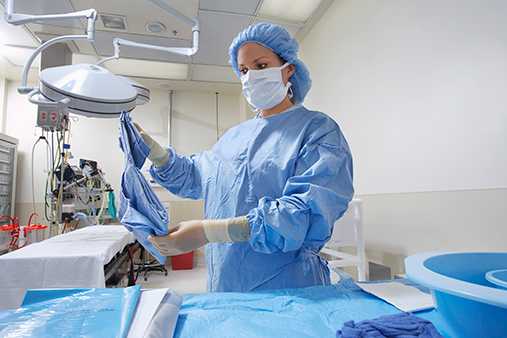Program Description

Over 20 million people are employed in private and public sector industries covered by the NIOSH Healthcare and Social Assistance (HCSA) program. These industries include ambulatory healthcare services, hospitals, nursing and residential care facilities and social assistance. These four industries are arranged on a continuum starting with those establishments providing medical care exclusively, continuing with those providing healthcare and social assistance, and finally finishing with those providing only social assistance. Because of the many parallels between human healthcare and animal healthcare, the HCSA program also includes two veterinary medicine/animal care (VM/AC) industries — veterinary services and pet care except veterinary services — and industries that employ laboratory animal care workers such as zoos and botanical gardens, and academic institutions, pharmaceutical and biotechnology companies, and others. However, services provided by farmers, ranchers and other workers in industries that are included in the Agriculture, Forestry and Fishing program are not within the scope of the HCSA program.
Employment growth in the human healthcare industries is expected to account for nearly 40% of the projected job growth for all industries from 2014 to 2024 – adding 3.8 million jobs during this period with a total employment of nearly 22 million (13.6% of U.S. private sector workforce) by 2024. An estimated 472 thousand people are employed in veterinary services, pet services, and zoos and botanical gardens. Veterinarians, veterinary technologists and technicians, and veterinary assistants and laboratory animal care comprise the major occupations in these industries and collectively are expected to grow by nearly 13% from 2014-2024.
Workers employed in industries covered by the HCSA program are at risk for injuries and illness because of lifting and repetitive tasks, long hours, changing shifts, violence (by patient or animal), stress, slippery or uneven walking surfaces, and exposure to infectious diseases and hazardous chemicals.
Research Areas
The HCSA Program works with partners in industry, labor, trade associations, professional organizations, and academia. The program focuses on these areas:
- Reducing work-related injuries in priority areas, such as injuries caused by patient lifting; violence; slips, trips, and falls; and use of sharps devices.
- Reducing work-related illnesses and associated risk factors, including infectious, respiratory, dermal, and other diseases and health outcomes.
Research Activities
- Disseminate useful prevention strategies for all affected workers. Reduce disparities through outreach to higher-risk, underserved and vulnerable worker populations.
- Address knowledge gaps that are barriers to developing effective prevention strategies. Examples include determining risk factors for disease transmission and injury mechanisms.
- Conduct surveillance for injuries, diseases, and risk factors. Provide findings to the research community, employers, workers, and other stakeholders to guide research and prevention efforts.
- Develop and demonstrate effective methods of prevention. Make recommendations that can be used by professional healthcare organizations, employers, workers, and government agencies.
Partnerships
The HCSA Program collaborates and works closely with a broad spectrum of constituents representing this sector. Our stakeholders and customers represent industry, labor, academia, government agencies, non-governmental organizations, and professional organizations both domestic and international. These organizations may be research partners, users of our technology and scientific findings, peer reviewers, recipients of research grants and contracts, or sources of equipment, technology, or knowledge for advancing research in this sector.
For information about partnering with the NIOSH HCSA Program, contact the HCSA Program Coordinator. For general information about partnerships with NIOSH, contact the NIOSH Research to Practice Office (R2P).
Practical Solutions
The NIOSH program for the HCSA sector is committed to the development of practical solutions to the complex problems that cause occupational diseases, injuries, and fatalities among workers in this sector.
- Workplace Violence Prevention Training for Nurses – This free, interactive course is designed to help healthcare workers better understand the scope and nature of violence in the workplace. Upon successful completion of the course, healthcare professionals can earn continuing education units.
- Training for Nurses on Shift Work and Long Work Hours -The purpose of this online training program is to educate nurses and their managers about the health and safety risks associated with shift work, long work hours, and related workplace fatigue issues and relay strategies in the workplace and in the nurse’s personal life to reduce these risks.
- Fast Facts: Home Healthcare Workers – Home healthcare workers allow patients to receive medical care in the comfort of their own homes, however, these workers are frequently exposed to a variety of potentially serious or even life-threatening hazards.
- Health and Safety Practices Survey of Healthcare Workers – Healthcare workers are potentially exposed to various hazardous chemicals. This survey evaluated how well best practices were followed for handling these chemicals and steps employers and employees can take to minimize exposure .
- Health Hazard Evaluation (HHE) Program – NIOSH conducts HHEs at individual worksites to find out whether there are health hazards to employees caused by exposures or conditions in the workplace.
- Page last reviewed: January 13, 2017
- Page last updated: June 8, 2017
- Content source:
- National Institute for Occupational Safety and Health Respiratory Health Division


 ShareCompartir
ShareCompartir